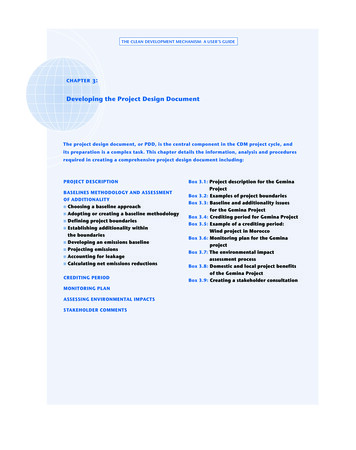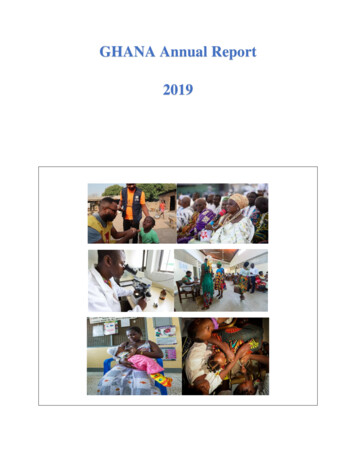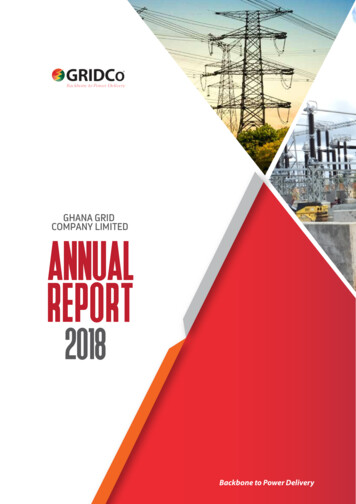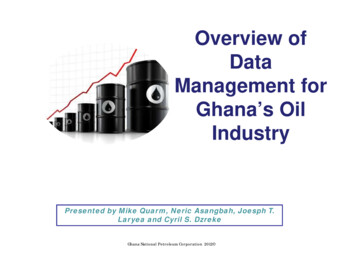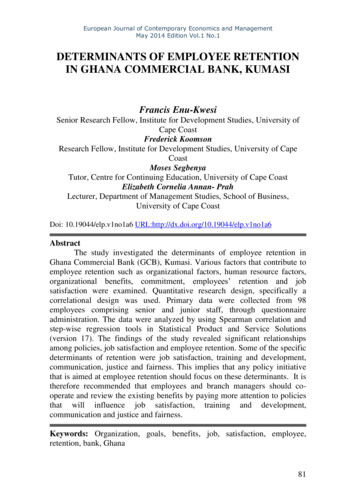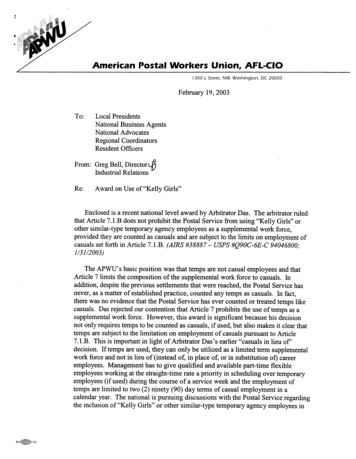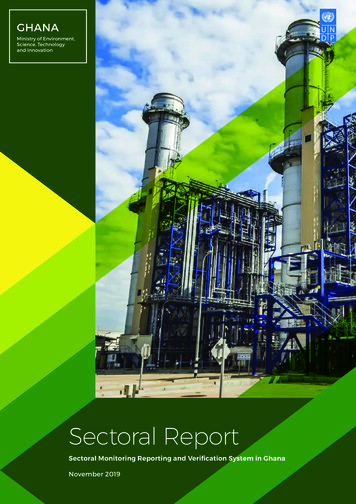
Transcription
GHANAMinistry of Environment,Science, Technologyand InnovationSectoral ReportSectoral Monitoring Reporting and Verification System in GhanaNovember 2019
TABLE OF CONTENTSList of Tables 3List of Figures 3Abbreviations and Acronyms 41INTRODUCTION TO THE ASSIGNMENT 51.1Introduction to the international monitoring reportingand verification system 51.2Evolution of the Ghana MRV system 51.3Approach to designing sectoral monitoring, reportingand verification 61.4Structure of the report 62GHG MITIGATION POTENTIAL AND THE EXISTINGDOMESTIC MRV SYSTEM 72.1Overview of GHG mitigation potential in Ghana 72.2Description of Ghana’s domestic MRV system 92.3Elements of Ghana’s NDC baseline and mitigation target 112.4Broad classification of mitigation measures in the NDC 163ACCOUNTING FOR NDC PROGRESS 3.1Tool for NDC accounting in Ghana 3.2Overview of enhanced transparencyframework reporting 3.33.3.1Linking the NDC accounting system to the national and sector-level GHG inventory Institutional arrangements203.4Reforms in the domestic MRV System 223.5Challenges of current MRV and gaps 224SECTORAL MRV FOR ENERGY AND TRANSPORT 4.1Overview of MRV issues in the energy andtransport sectors 4.24.2.14.2.2Data and methodological issues in the energy andtransport sectors Fuel allocation in industryTransport data5GHG ACCOUNTING FOR NATIONALLY DETERMINED CONTRIBUTIONS 295.1Brief description of the NDC accounting steps 295.25.2.15.2.2Requirements of the national NDC accounting system Data requirementsMethodology for computing achievement of NDC targets306TOOL TO CALCULATE NDC IMPACTS 6.1Overview of the NDC GHG accounting tool 336.26.2.16.2.26.2.36.2.46.2.56.2.6Features of the NDC accounting tool Introduction sheetsBusiness-as-usual emission sheetNational NDC targetsGHG inventory-based trackingMeasure-based trackingNDC tracking dashboard337CONCLUSIONS AND RECOMMENDATIONS 7.2Recommendations 7.11818192626Conclusions 2633414141References 42Glossary 432
LIST OF TABLESTable 1: Existing data sources used for the Biennial Update Report and National Communication in Ghana 10Table 2: Breakdown of NDC mitigation measures by sector and their emission reduction potential (ERP)between 2016 and 2030 16Table 3: Twenty mitigation measures, targets and emission reduction potential (ERP) 17Table 4: Overview of climate change reporting elements under the current MRV and future ETF regimes 19Table 5: Institutional arrangement for Ghana’s national greenhouse gas inventory 21LIST OF FIGURESFigure 1: Share of 2014 greenhouse gas emissions among the top five emitters in the ECOWAS Sub-region 7Figure 2: Ghana’s economy-wide mitigation potentials, linkages with NDC targets and correspondingMRV requirements for the respective mitigation measures 8Figure 3: Overview of Ghana’s NDC mitigation commitment. 12Figure 4: Components of the shift required for Ghana to participate effectively in the enhancedtransparency framework introduced under Article 13 of the Paris Agreement 18Figure 5: Key elements of the enhanced transparency framework (adaptation is not included becausethis focuses on mitigation action) 20Figure 6: Cost points of GHG inventory preparation (in %). 24Figure 7: Overview of the proposed national NDC accounting system 29Figure 8: Relationship among GHG inventory, BAU emissions, unconditional and conditional targets, NDCactions and the assigned emissions: 1 represents historical emissions obtained from the national GHGinventory; 2 represents projected BAU emissions under the status quo emission trajectory; 3 and 4 depictthe unconditional and conditional emission reduction targets; 5 and 6 represent emission reductions fromimplementation of the two unconditional and the 18 conditional NDC mitigation actions, respectively; 7 isassociated with emission reductions from mitigation action outside the NDC; and 8 refers to remaining GHGemissions generated from the national GHG inventory. 303
ABBREVIATIONS AND ACRONYMSADActivity DataGWPGlobal Warming PotentialAFOLUAgriculture, Forestry and Other Land UseICAInternational Consultation and AnalysisBAPBali Action PlanICATInitiative for Climate Action ntal Panel on Climate ChangeBRRIBuilding and Road Research InstituteIPPUIndustrial Process and Product UseBTRBiennial Transparency ReportITMOsInternationally Transferred Mitigation OutcomesBURBiennial Update ReportKCAKey Category AnalysisCCConditional targetKPKyoto ProtocolCERsCertified Emission ReductionsMESTIMinistry of Environment Science Technologyand InnovationCERSGISCentre for Remote Sensing and GeographicInformation ServicesMRVMonitoring Reporting and VerificationCORSIACarbon Offsetting and Reduction Scheme forInternational AviationMRVMonitoring Reporting VerificationDVLADriver Vehicle Licensing AuthorityMWMegawattEFEmission FactorsNAPNon-Annex PartiesEPAEnvironmental Protection AgencyNCNational CommunicationsERPEmission Reduction PotentialNDCNationally Determined ContributionsETFEnhanced Transparency FrameworkNDPCNational Development Planning CommissionFSVFacilitative Sharing of ViewsNIRNational Inventory ReportGCNetGhana Community Network SystemPAParis AgreementGDPGross Domestic ProductsQA/QCQuality Assurance/Quality ControlGEFGlobal Environment FacilityRACRefrigeration and Air-conditionGHGIGreenhouse Gas InventoryREDD Reducing Emissions from Deforestationand Forest DegradationGLSSGhana Living Standard SurveyUCUnconditional targetGSSGhana Statistical ServiceUNFCCCUnited Nations Framework Conventionon Climate Change4
1INTRODUCTION TO THE ASSIGNMENT1.1INTRODUCTION TO THE INTERNATIONAL MONITORING REPORTINGAND VERIFICATION SYSTEMThe Parties to the United Nations Framework Convention on Climate Change (UNFCCC) must regularly publish theirnational communications (NCs). The NCs are to carry information on national greenhouse gas emission inventory, stepstaken to implement the UNFCCC in-country, and any other information relevant to the objective of the Convention.Under the reporting arrangements, the Annex 1 Parties reported their NCs every four years, while the Non-Annex 1Parties (NAP) had no reporting timelines. Reporting under the UNFCCC has been reformed significantly. When the 34industrialised nations adopted the Kyoto Protocol (KP), strict annual reporting and technical review were introduced toevaluate progress towards achieving their emission reduction targets and ensured continued participation in the KP.The Bali Action Plan (BAP) established a global monitoring, reporting, and verification (MRV) system, which soughtto enhance the Parties’ climate reporting. The international MRV scheme introduced enhanced reporting (four yearsfor national communication and two years for the Biennial Update Report, BUR) and report review through two-steptechnical and multilateral reviews under the international consultation and analysis (ICA) process. Countries wererequired to establish an enhanced domestic MRV system to enable them to participate effectively in the internationalclimate regime. Under the changes, countries had to set up functional national arrangements so that they could compileand publish credible and timely climate reports and participate effectively in the ICA. In addition to rationalising theNC reporting timelines and adding NAP’s BUR, the content was also changed. The reporting elements in the NCsremained mostly unchanged, but the BUR now includes new items such as mitigation action and effects, domesticMRV, and support needed and received. The enhanced MRV regime will continue until 2024 when it is replaced bythe enhanced transparency framework under the Paris Agreement (PA). Therefore, developing countries must preparefor a smooth shift to the enhanced transparency framework (ETF). This transition will undoubtedly require consistentefforts to strengthen the existing MRV arrangements.1.2EVOLUTION OF THE GHANA MRV SYSTEMThe purpose of establishing the domestic MRV system is to localise international reporting and incorporate it as anintegral part of the government structure. In practice, this is a national arrangement that guides the systematic steps toregularly collect and process data and publish information on GHG emissions, mitigation actions, and their effects andsupport. The objective is to increase the transparency of mitigation actions that the country implements and to buildconfidence among all countries1. Ghana produces updated national greenhouse gas estimates every two years. Theestimates are generated based on greenhouse gas emissions (CO2, CH4, N2O and PFCs) from the energy, industrialprocess, agriculture, forestry, and other land use and waste sectors, using the 2006 IPCC methodology. The energyand transport sectors are key contributors to economic growth and GHG emission in Ghana. The energy sector is thesecond-leading source of emissions currently, contributing 15.02 MtCO2e (35.6 percent) of national emissions, behindAFOLU (agriculture, forestry and other land use)2. Within the energy sector, transportation accounts for most emissions.Its 7.2 MtCO2e emissions in 2016 are responsible for 48 percent of total energy emissions and 17 percent of overallnational emissions3.However, quantifying energy and transport sector emissions is more challenging due to the lack of accurate data andthe difficulties associated with the data collection system. By 2024, countries that are Parties to the UNFCCC and theParis Agreement will report on national communications and through the Biennial Transparency Report (BTR). UNFCCCcompliant nations will submit their national communications every four years. Since Ghana is a party to both UNFCCCand the PA, it would continue to report the NC every four years and begin compiling BRT in 2024, when the last BUR ispublished. Ghana thus needs to sustain its efforts to strengthen the existing national MRV system so that it respondsto the EFT. Consequently, facilitating the development of workable sector-specific MRV systems for the energy and thetransport sectors would be important steps towards establishing a functional climate reporting system in the country.123UNFCCC, 2011EPA, 2019: Ghana’s Fourth National Greenhouse Gas Inventory ReportEPA, 2019: Ghana’s Fourth National Greenhouse Gas Inventory Report5
This report is the culmination of a joint effort to evaluate the current state of Ghana’s MRV system and propose practicalways to institutionalise it in the energy and transport sectors. The assignment was originally focused on designingenergy and transport sector-specific MRV, but the team has developed an MRV tool that applies to all NDC sectors.However, the team has used energy and transport case examples throughout this document to illustrate salient conceptsof MRV. The document’s purpose is to understand MRV practices and suggest concrete methods to strengthen theaccuracy of GHG estimates and mitigation actions to achieve its national targets, as well as to ensure accountabilityin terms of support received. The aim is to develop a tailor-made MRV tool across all NDC sectors, including energyand transport. The tool will help the Government of Ghana to report on the progress of all NDC mitigation actions inall sectors.1.3APPROACH TO DESIGNING SECTORAL MONITORING, REPORTINGAND VERIFICATIONIn line with the objectives outlined in the TOR, the consultants approached the assignment in three main stages. Thefirst involved conducting a comprehensive review of the National Greenhouse Gas Inventory (GHGI) and BiennialUpdate reports to UNFCCC, policy documents on Ghana’s MRVs, Ghana’s NDC and other international MRV trackingsystems. The review produced the National MRV Assessment Report of Ghana, submitted to the Ministry of Environment,Science, Technology and Innovation (MESTI) within the framework of this work. The assessment helped the team tounderstand how Ghana’s national MRV system operates and identify gaps, challenges and efforts to address themto enhance the transparency and tracking of NDC targets and progress. The second stage involved consulting withMESTI/Environmental Protection Agency (EPA) and other key stakeholders to develop an in-depth understanding ofthe challenges of MRV tracking in Ghana. In the third stage, the consultants worked closely with the EPA to develop anMRV tool that can be used to monitor and report progress on the NDC and shared the draft with the UNDP for reviewand inputs. The fourth stage involved holding a stakeholder consultative workshop to test the suitability of the MRVtool and solicit their input for integration into the final version.1.4STRUCTURE OF THE REPORTThis document includes seven chapters: Chapter 1 introduces the report. It provides background information on the broad elements of MRV, highlighting theneed for sector-specific MRV for the energy and transport sectors.Chapter 2 presents an overview of Ghana’s mitigation potential and the existing MRV system. It reviews the existingMRV system, challenges encountered and the gaps identified, which informed the development of the energy andtransport sector-specific MRV.Chapter 3 discusses the tracking of Ghana’s nationally determined contributions. It presents an overview of ETF, theNDC to national and sector-level GHG inventory, institutional arrangements, MRV reforms and challenges.Chapter 4 presents the MRV for the energy and transport sectors. It covers the national accounting system, requirementsof the national NDC accounting system, data requirements and methodologies. This includes the institutionalarrangements for implementing the sector-specific MRV system and for coordinating MRV related aspects. It alsodefines the role and responsibility of each institution, including for measuring and reporting the various parameters,managing the data management system, aggregating data, and conducting verification.Chapter 5 covers GHG accounting for NDC under the ETF regime. It describes the NDC accounting steps andrequirements of the national NDC accounting system. This includes the data requirements and methodology forcomputing achievement of NDC targets. The chapter also describes the methods for calculating achievement of NDCand assessing NDC impacts.Chapter 6 presents an Excel-based tool developed to facilitate calculation of the achievement of NDC targets. It detailsthe NDC accounting tool calculation options for tracking the NDC, features and steps and how they are linked in aworksheet. It also describes the five main elements required to determine NDC progress. These include business-asusual emissions, national NDC targets, GHG inventory-based tracking, measure-based tracking and the NDC trackingdashboard.Last, Chapter 7 offers conclusions and recommendations for successful implementation of the tool.6
2GHG MITIGATION POTENTIAL AND THEEXISTING DOMESTIC MRV SYSTEM2.1OVERVIEW OF GHG MITIGATION POTENTIAL IN GHANAGhana’s 42 million tonnes of greenhouse gas is just a small fraction of Africa’s 4 percent of contributions to globalemissions (Figure 1). However, the country is among the top six largest GHG emitters in the ECOWAS subregion4. Its totalnational emissions have increased by 66 percent over the period 1990-2016 and are projected to nearly double to 74MtCO2e by 2030 along the BAU trajectory. Given this trend, it is quite likely that emissions will exceed their allowablelimits if concrete steps are not taken to reduce them. If the current economic structure is not modified, emissions willcontinue to increase and, even, worsen beyond 2030. Ghana’s rising emissions trend correlates positively with observedGDP and population growth5.73 R6 54Figure 1: Share of 2014 greenhouse gas emissions among the top five emitters in the ECOWAS Sub-region4.5%4.9%SenegalBurkina Faso5.7%Ghana5.8%Mali5.8%CÔte d’Ivoire73.3%NigeriaControlling increasing emissions in the future would require implementing cost-effective mitigations, using a wide arrayof fiscal, regulatory and technological measures. The country’s GHG mitigation potential varies by economic sectorbecause it is based on costs and available technology. Mitigation strategies entail both the question of the extent ofcost-effective GHG emissions reduction in a given period and the ability to make the correct policy choices to achievethe targets set. Several factors thus come into play when countries or entities develop mitigation targets and theaccompanying strategies to achieve them. One key factor is determining a country’s ability to achieve its goal basedon its economic circumstances. While some influential industrial countries have committed to a net-zero target6, otheremerging or developing nations have adopted a medium-term mitigation goal that is below business-as-usual or baseyear emissions. Another major step involves selecting a suitable mitigation accounting metric based on a transparentand robust methodology. The accounting metric a country selects is usually used to systematically assess GHGbaselines and ex-ante impacts of the mitigation action and to track progress towards and achievement of the statedtarget. Ghana has adopted a BAU deviation emission target approach. Its overall BAU emissions target is 74 MtCO2eby 2030, projected from 2010 historical emissions of 20 MtCO2e, and a corresponding target of 45 percent emissionreduction (33 MtCO2e) below the BAU s-data-sources 42&historical-emissions-gases 177&historicalemissions-regions ions-sectors 509&page h nir4-1.pdfIn June 2019, the UK Government announced a new net-zero carbon commitment by 2050 to replace the existing 80% emission cut by the same year asfound in the 2008 Climate Change Act. 7757
This means that by 2030, Ghana is expected to reduce its total national greenhouse gas emissions from the projected74 MtCO2e to 41MtCO2e when all 20 mitigation measures in the NDC are fully implemented. This translates roughlyinto 33MtCO2e emission reductions over the 10 years. The remaining 41 MtCO2e are potential reductions that could beachieved with the mitigation actions outside the scope of the NDC (Figure 2). Ghana has identified two categories ofmitigation measures. The 20 mitigation measures were originally captured in the NDC and labelled “IN,” whereas all theother measures that fall outside the NDC are classified as “OUT” (Figure 2). Financing for the IN mitigation actions maycome from multiple fund-based (climate finance) and market-based (carbon market mechanism) sources7 or a mixtureof them. The same financing arrangements may apply to the OUT mitigation actions. However, the MRV arrangementfor IN and OUT measures would differ for the two financing tracks.Typically, MRV for market-based mitigation measures tends to be stricter because the resulting GHG emission reductionsmay be exchanged for cash payments or other financial instruments. Therefore, market-based mitigation units must meethigher verification standards before emission reduction credits are issued to the intended owner with legal entitlement.This, in turn, means that the units generated must have been subject to rigorous monitoring, reporting and verification at thefacility level before payments is issued. The facility operator performs monitoring and reporting at the project level beforethird-party verification. The bottom line is that all NDC mitigation actions funded through carbon finance schemes (such asCERs, ITMOs, CORSIA and REDD ) with a view to exchanging units for payment must comply with the funding conditions.The NDC mitigation measures under non-market funding may not necessarily be subject to the strict MRV system in thesame way as the market-based ones. This is because the mitigation outcomes from implementation are of limited use ormay not be used in commercial transactions for payments. Thus,
Figure 4: Components of the shift required for Ghana to participate effectively in the enhanced . ERP Emission Reduction Potential ETF Enhanced Transparency Framework . 2 EPA, 2019: Ghana’s Fourth National Greenhouse Gas Inventory Report
